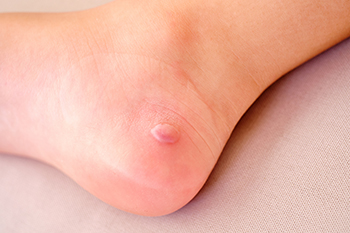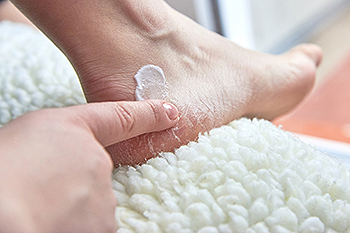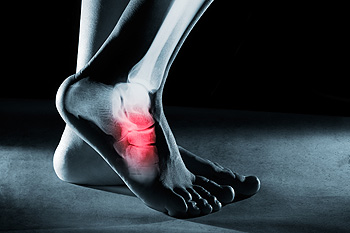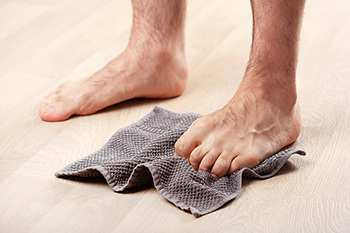Connect With Us
Blog
Items filtered by date: December 2023
Do You Suffer From Painful Feet?
Causes and Symptoms of Foot Blisters

Foot blisters are tiny fluid-filled sacs that form on the skin. They may seem inconspicuous but can be surprisingly uncomfortable, often arising from a combination of factors. Friction stands as a primary cause, especially when ill-fitting footwear or repetitive motion induces rubbing against the skin. Moisture and heat exacerbate the risk, as sweaty or damp conditions soften the skin, making it more prone to friction-related blisters. Additionally, poorly managed moisture, whether from excessive sweating or wet environments, creates an ideal environment for blisters. The symptoms of foot blisters include localized pain, tenderness, and a distinct swelling filled with clear fluid. The affected area may become red, and in more severe cases, the blister may rupture, leading to an open wound susceptible to infection. If you repeatedly develop foot blisters, it is suggested that you confer with a podiatrist who can offer effective relief and prevention methods.
Blisters are prone to making everyday activities extremely uncomfortable. If your feet are hurting, contact one of our podiatrists of Kokomo Foot & Ankle Center. Our doctors can provide the care you need to keep you pain-free and on your feet.
Foot Blisters
Foot blisters develop as a result of constantly wearing tight or ill-fitting footwear. This happens due to the constant rubbing from the shoe, which can often lead to pain.
What Are Foot Blisters?
A foot blister is a small fluid-filled pocket that forms on the upper-most layer of the skin. Blisters are filled with clear fluid and can lead to blood drainage or pus if the area becomes infected.
How Do Blisters Form?
Blisters on the feet are often the result of constant friction of skin and material, usually by shoe rubbing. Walking in sandals, boots, or shoes that don’t fit properly for long periods of time can result in a blister. Having consistent foot moisture and humidity can easily lead to blister formation.
Prevention & Treatment
It is important to properly care for the affected area in order to prevent infection and ease the pain. Do not lance the blister and use a Band-Aid to provide pain relief. Also, be sure to keep your feet dry and wear proper fitting shoes. If you see blood or pus in a blister, seek assistance from a podiatrist.
If you have any questions, please feel free to contact our office located in Contact Us . We offer the newest diagnostic and treatment technologies for all your foot care needs.
A Closer Look at Causes of Cracked Heels

Cracked heels, a common foot ailment, manifest as fissures or splits in the skin around the heel area. The primary cause of this condition lies in the lack of moisture, leading to dry and hardened skin. Prolonged standing or walking on hard surfaces can exacerbate the problem, as the pressure on the feet intensifies. Obesity is another contributing factor, as excess weight puts additional strain on the feet, fostering the development of cracks. In some cases, underlying medical conditions such as diabetes or hypothyroidism may contribute to the dryness of the skin, increasing the risk of cracked heels. Lack of proper foot care, including infrequent moisturizing and neglecting to exfoliate dead skin, further amplifies the susceptibility to cracked heels. Understanding these causes is pivotal for adopting preventive measures and a comprehensive foot care routine, ensuring the maintenance of soft, healthy heels. If you have developed cracked heels, it is suggested that you visit a podiatrist who can offer you correct treatment and prevention techniques.
Cracked heels are unsightly and can cause further damage to your shoes and feet. If you have any concerns, contact one of our podiatrists from Kokomo Foot & Ankle Center. Our doctors can provide the care you need to keep you pain-free and on your feet.
Cracked Heels
Cracked heels appear unappealing and can make it harder for you walk around in sandals. Aside from looking unpleasant, cracked heels can also tear stockings, socks, and wear out your shoes. There are several methods to help restore a cracked heel and prevent further damage.
How Do You Get Them?
Dry skin is the number one culprit in creating cracked heels. Many athletes, walkers, joggers, and even swimmers suffer from cracked heels. Age and skin oil production play a role to getting cracked heels as well.
Promote Healing
Over the counter medicines can help, especially for those that need instant relief or who suffer from chronic dry feet.
Wear Socks – Wearing socks with medicated creams helps lock in moisture.
Moisturizers – Applying both day and night will help alleviate dryness which causes cracking.
Pumice Stones – These exfoliate and remove dead skin, which allows for smoother moisturizer application and better absorption into the skin.
Change in Diet
Eating healthy with a well-balanced diet will give the skin a fresh and radiant look. Your body responds to the kinds of food you ingest. Omega-3 fatty acids and zinc supplements can also revitalize skin tissue.
Most importantly, seek professional help if unsure how to proceed in treating cracked heels. A podiatrist will help you with any questions or information needed.
If you have any questions, please feel free to contact our office located in Contact Us . We offer the newest diagnostic and treatment technologies for all your foot care needs.
Causes and Risk Factors of Foot Stress Fractures

Foot stress fractures, tiny cracks in the bones, can emerge from a myriad of factors that subject the feet to repetitive stress and strain. One primary cause is overuse, where excessive or sudden increases in physical activity like running or prolonged standing surpass the bones' capacity for repair. Wearing inadequate footwear or worn-out shoes lacking proper support amplifies the risk, as they fail to absorb shock adequately. Biomechanical factors, like abnormal foot structure or gait patterns, contribute to uneven weight distribution, placing specific areas under heightened stress. Insufficient conditioning and muscle fatigue diminish the ability of muscles to absorb impact, transferring excess force to the bones. Additionally, nutritional deficiencies, particularly in calcium and vitamin D, compromise bone strength, elevating the susceptibility to stress fractures. By wearing proper footwear, adopting a gradual training progression, and supplying nutritional support, individuals can fortify their foot health and reduce the likelihood of encountering the discomfort associated with stress fractures. If you have developed a foot stress fracture, it is suggested that you are under the care of a podiatrist who can offer you the treatment option that is right for you.
Stress fractures occur when there is a tiny crack within a bone. To learn more, contact one of our podiatrists from Kokomo Foot & Ankle Center. Our doctors can provide the care you need to keep you pain free and on your feet.
How Are They Caused?
Stress fractures are the result of repetitive force being placed on the bone. Since the lower leg and feet often carry most of the body’s weight, stress fractures are likely to occur in these areas. If you rush into a new exercise, you are more likely to develop a stress fracture since you are starting too much, too soon. Pain resulting from stress fractures may go unnoticed at first, however it may start to worsen over time.
Risk Factors
- Gender – They are more commonly found in women compared to men.
- Foot Problems – People with unusual arches in their feet are more likely to develop stress fractures.
- Certain Sports – Dancers, gymnasts, tennis players, runners, and basketball players are more likely to develop stress fractures.
- Lack of Nutrients – A lack of vitamin D and calcium may weaken the bones and make you more prone to stress fractures
- Weak Bones – Osteoporosis can weaken the bones therefore resulting in stress fractures
Stress fractures do not always heal properly, so it is important that you seek help from a podiatrist if you suspect you may have one. Ignoring your stress fracture may cause it to worsen, and you may develop chronic pain as well as additional fractures.
If you have any questions, please feel free to contact our office located in Contact Us . We offer the newest diagnostic and treatment technologies for all your foot care needs.
Suggested Exercises for Flat Feet

Flat feet, or fallen arches, can lead to discomfort and negatively affect your posture, which can cause problems in other parts of the body. Strengthening the arches through targeted exercises for flat feet not only helps alleviate this discomfort but can also contribute to improved posture in the long run. The towel scrunch and stair heel raises are two of many exercises that can improve your arch strength. For the towel scrunch exercise, sit on a chair with a towel laid flat under your feet. Using only your toe muscles, scrunch the towel toward you until you can't pull it any further. Complete two sets with each foot and gradually increase sets as you feel more comfortable. To perform stair heel raises, stand on a step with only your toes and the balls of your feet on the step. Slowly raise your heel into the air, holding for a few seconds. Resist lowering your heel below the stair line for effectiveness. Begin with 10 raises as one set, aiming for three sets per day without pain. These exercises are designed for all fitness levels and can be done in the comfort of your home. Start at a beginner level and progress at your own pace. If you experience pain, it is a sign to stop. Also, it is beneficial to skip a day if your muscles are sore. For further guidance on methods to manage flat feet, it is suggested that you schedule an appointment with a podiatrist.
Flatfoot is a condition many people suffer from. If you have flat feet, contact one of our podiatrists from Kokomo Foot & Ankle Center. Our doctors will treat your foot and ankle needs.
What Are Flat Feet?
Flatfoot is a condition in which the arch of the foot is depressed and the sole of the foot is almost completely in contact with the ground. About 20-30% of the population generally has flat feet because their arches never formed during growth.
Conditions & Problems:
Having flat feet makes it difficult to run or walk because of the stress placed on the ankles.
Alignment – The general alignment of your legs can be disrupted, because the ankles move inward which can cause major discomfort.
Knees – If you have complications with your knees, flat feet can be a contributor to arthritis in that area.
Symptoms
- Pain around the heel or arch area
- Trouble standing on the tip toe
- Swelling around the inside of the ankle
- Flat look to one or both feet
- Having your shoes feel uneven when worn
Treatment
If you are experiencing pain and stress on the foot you may weaken the posterior tibial tendon, which runs around the inside of the ankle.
If you have any questions please feel free to contact our office located in Contact Us . We offer the newest diagnostic and treatment technologies for all your foot and ankle needs.

